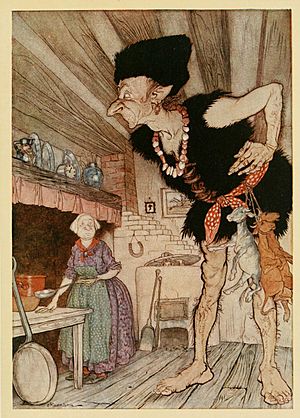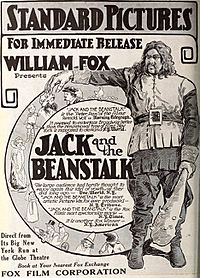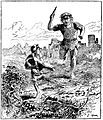Jack and the Beanstalk facts for kids
Quick facts for kids Jack and the Beanstalk |
|
|---|---|

Illustration by Arthur Rackham, 1918, in English Fairy Tales by Flora Annie Steel
|
|
| Folk tale | |
| Name | Jack and the Beanstalk |
| Also known as | Jack and the Giant man |
| Data | |
| Aarne–Thompson grouping | AT 328 ("The Treasures of the Giant") |
| Country | England |
| Published in | Benjamin Tabart, The History of Jack and the Bean-Stalk (1807) Joseph Jacobs, English Fairy Tales (1890) |
| Related | "Jack the Giant Killer" |
Jack and the Beanstalk is an English fairy tale, closely associated with the tale of Jack the Giant Killer. It is known under a number of different versions, but the tale was popularized by Joseph Jacobs in English Fairy Tales, whose version is most commonly reprinted today. The story was made into a play by Charles Ludlam. Due to the fable, another name for a space elevator is a "beanstalk."
Plot synopsis
Jack was a poor boy whose lack of common sense often drove his widowed mother to despair. One day she sent him to the market to sell their last and only possession, a cow, but along the way, Jack met a stranger who offered to trade it for five "magic beans". Thrilled at the prospect of owning magic beans, Jack made the deal without hesitation.
Alas, his mother turned out to be less than thrilled when he arrived back home. She threw the beans straight out of the window and sent Jack to bed without dinner. Overnight however, the seeds grew into a gigantic beanstalk. It reached so far into the sky that the top went completely out of sight. Eager as the young boy was, Jack immediately decided to climb the plant and arrived in a land high up in the clouds, which was the home of the giant. When he broke into his castle, the giant quickly sensed a human was near and chanted loudly:
- Fee! Fie! Foe! Fum!
- I smell the blood of an Englishman.
- Be he 'live, or be he dead,
- I'll grind his bones to make my bread.
However, Jack was saved by the giant's wife, and as he escaped from the palace, he took some gold coins with him. Back home, the boy and his mother celebrated their newfound fortune, but their luck did not last, and Jack climbed the beanstalk once more. This time he stole a hen which laid golden eggs. Again he was saved by the giant's wife. He went down the ladder and showed the chicken to his mother, and the two lived happily on the proceedings from the hen's eggs.
Eventually, Jack grew bored, and resolved to climb the beanstalk a third time. This time, he stole a magical harp that sung to itself. The instrument did not appreciate being stolen, and called out to the giant for help. The giant chased Jack down the beanstalk, but luckily the boy got to the ground before he did. Jack immediately chopped it down with an axe. The giant fell to earth, hitting the ground so hard that it split, pulling the beanstalk down with him.
Images for kids
-
1854 illustration of Jack climbing the beanstalk by George Cruikshank
-
In Walter Crane's woodcut the harp reaches out to cling to the vine
-
Jack running from the giant in the Red Fairy Book (1890) by Andrew Lang
-
Jack and the Beanstalk pantomime showing in Cambridge, England
See also
 In Spanish: Jack y las habichuelas mágicas para niños
In Spanish: Jack y las habichuelas mágicas para niños







